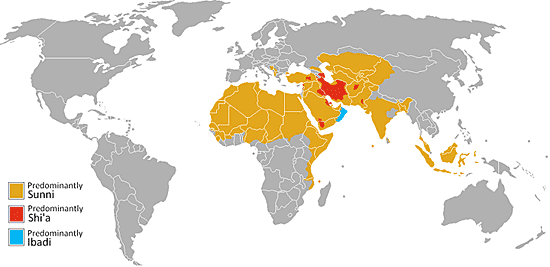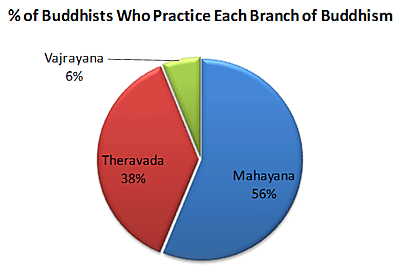
Unit 1: Redefining World Society and Culture
Lesson B: Division and Diffusion — World Belief Systems
Activity 9: Unity and Division in Islam and Buddhism

Distribution of Islam [1]
Schism in Islam
By examining the map above, we can conclude that there was at least one schism in Islam. This would account for the map labeling different groups of Muslims. The most significant schism in Islam was the Sunni-Shiite split.
Beginning in the 700s a disagreement emerged over who should be the leader of Islam. One group, the Sunni, argued that any good Muslim could be a leader. The Shiite argued that only a descendant of Muhammad could lead the faith. This disagreement, along with some other disagreements over some religious practices and leadership within Islam, led to this major split in Islam. Take a moment to examine the map and note the location of Sunni and Shiite Muslims today.

[2]
Schism in Buddhism
By looking at the pie chart of Buddhism, we can conclude that Buddhism, like Christianity and Islam, had a schism that led to different branches. In the chart, you should note that the two largest branches of Buddhism are Mahayana and Theravada.
The schism that created these two branches occurred in the 4th century BCE. Issues such as which scriptures should be accepted as holy books, diet restrictions such as vegetarianism, and the merging local cultures with Buddhist practices caused this schism. Theravada Buddhists are the more "traditional" of the two with Mahayana Buddhists more flexible in how they adapted the practices of Buddhism to fit with different cultures.
Written Activity - Notebook
In your notebook, respond to the following questions:
- What are some of the common disagreements that led to the schisms described for these three religions?
- What are some of the differences among what led to these schisms?
Page Notes:
[1] Source: This image from http://commons.wikimedia.org/wiki/File:Sunni-Shi%27a_map.png is in the public domain.
[2] Source: This image has been created with information from http://www.adherents.com/adh_branches.html#Buddhism.

